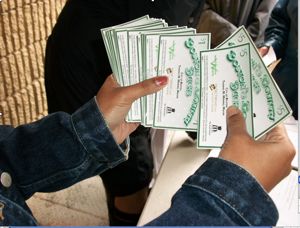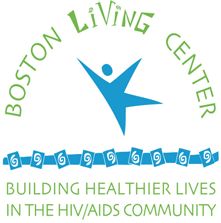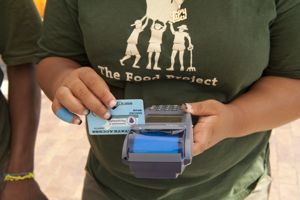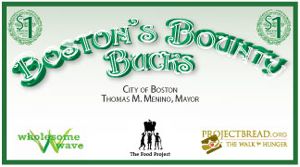SNAP to the Farmers’ Market
Air Date: Week of November 12, 2010
 |
The Supplemental Nutrition Assistance Program, known as SNAP, provides low-income Americans with assistance to buy food. The city of Boston is providing even more help, and creating extra incentives to encourage healthy eating. LOE’s Jessica Ilyse Smith went to a farmers’ market to find out about the Boston Bounty Bucks program.
Transcript
GELLERMAN: The Thankgiving season is near – and yet, for many families in the US, the economy gives little to be thankful for. At this year’s dinner they’ll have to do without many of the fixings and blessings of years past.
These days nearly forty-two million Americans receive monthly help from the federal program once known as food stamps. Today it’s SNAP—the Supplemental Nutrition Assistance Program. Now, some cities are also trying to help.
LOE’s Jessica Ilyse Smith went shopping with some people receiving SNAP benefits- trying to balance a healthy diet with limited incomes.
[FARMERS’ MARKET SFX]
SMITH: On a recent afternoon the farmers’ market in Boston’s Copley Square is bustling with energy.
WOMAN: Do you want me to lift that bag up for ya?
[SOUNDS OF BAGGING AND BEEPING REGISTER]
SMITH: Today a group from the Boston Living Center is on a field trip.

Boston Bounty Bucks. (Photo: The Food Project)
HANSEN: We decided to come to the market today to learn how to use the food stamps and also use the Boston Bounty Bucks.
SMITH: Amber Hansen is the Boston Living Center’s registered dietician. She organized this outing to help the Center’s HIV positive members shop for produce using Bounty Bucks—the city’s program that doubles Federal SNAP benefits. It’s a dollar-for-dollar match up to ten dollars.
HANSEN: Do you want some cauliflower, or are you good?
CARLOS: how much is it?
HANSEN: Four dollars a pound. You could roast it with olive oil, garlic and salt. If you just chop it up. And then put some oil on it. Do you have olive oil or canola oil even? Both are healthy, good fats.
SMITH: Hansen gives Carlos tips on how to choose and cook his produce.
For Carlos and others living with compromised immune systems, fresh fruits and vegetables are especially important for their nutrition. Janet’s another member of the Boston Living Center.
JANET: When you’re living with HIV even though now, with the medicines a lot of people are living longer, but it’s very important to take care of yourself. Good nutrition is kind of a way to fight back.

SMITH: But fresh produce can be prohibitively expensive. Boston Bounty Bucks is trying to make healthy food more attainable for low-income residents. Edith Murnane is Boston’s director of food initiatives. When I visited her at her office in City Hall she told me this program is all about accessibility.
MURNANE: Farmer’s markets are a really interesting way to get fruits and vegetables into the inner city. I’m not only talking about physical accessibility, but it’s really economic accessibility and the Boston Bounty Bucks really gets at that.
SMITH: The program also helps out farmers.
MURNANE: It makes it economically viable for a farmer to come to the inner city. It makes it economically feasible.
SMITH: There are now 21 farmers’ markets that participate in the program—Murnane says this shows the city’s strong commitment to public health.
[FARMER’S MARKET SFX]
SMITH: The program is helping the city’s farmers’ markets accommodate SNAP users by providing grants for new technology. Lee Piper is the assistant farm manager at the Copley Square Market.
PIPER: We have a wireless terminal here at the market, so we can take your EBT card and swipe it through.
SMITH: The terminal logs on to each person’s SNAP benefits and matches up to ten dollars in Bounty Bucks. Piper shows Living Center members how to use their Electronic Benefit Transfer, or EBT cards.

A sign at the market advertising the Boston Bounty Buck program. (Photo: The Food Project)
PIPER: So I swipe this.
[BEEP OF MACHINE]
PIPER: Now, you need to enter your 4-digit pin number.
[BEEPS OF PIN, SOUND OF PAPER ROLLING OUT AND RIPPING]
SMITH: Piper hands Carlos his receipt and counts out 20 Bounty Bucks.
PIPER: 16,17,18,19, and 20. So that’s what you can spend.
CARLOS: Alright.
SMITH: Armed with his 20 Bounty Bucks, Carlos decides what to buy.
CARLOS: What I would like to buy…se llama? Collard? Collard greens. I love romaine lechuga, lettuce.

Using a SNAP EBT card at the farmers’ market. (Photo: The Food Project)
SMITH: Carrying bags of lettuce, collard greens, onions and mushrooms, Carlos gets in line to pay.
WOMAN: Do you want me to lift that bag up for you?
[SOUNDS OF BAGGING]
CASHIER: 13.75 is your total.
CARLOS: Gracias, thank you!
HANSEN: So the Bounty Bucks are a big help!
CARLOS: Oh my god!
HANSEN: Yeah! Right?
CARLOS: Yes. This is like for me seven dollars. 50% discount, 20 dollars for ten dollars! And I’m more positive that I come back more often.

A Bounty Buck.
SMITH: That’s exactly why Boston sponsors Bounty Bucks—to have customers return to the market throughout the growing season and eat more fruits and vegetables. The program has become a model for other cities. Farmers’ markets around the country are starting to add EBT stations and a few other programs offer financial incentives. The goals are the same: to improve health and nutrition in traditionally underserved populations.
[MARKET SOUNDS]
WOMAN: How many pounds is that? This is one…
SMITH: For Living on Earth, I’m Jessica Ilyse Smith.
WOMAN: So we could just get a couple? They really are delicious…
[MUSIC: Hugh Masakela “The Market Place” from Live At The Market Theater (Four Quarters Records 2007)]
Links
Living on Earth wants to hear from you!
Living on Earth
62 Calef Highway, Suite 212
Lee, NH 03861
Telephone: 617-287-4121
E-mail: comments@loe.org
Newsletter [Click here]
Donate to Living on Earth!
Living on Earth is an independent media program and relies entirely on contributions from listeners and institutions supporting public service. Please donate now to preserve an independent environmental voice.
NewsletterLiving on Earth offers a weekly delivery of the show's rundown to your mailbox. Sign up for our newsletter today!
 Sailors For The Sea: Be the change you want to sea.
Sailors For The Sea: Be the change you want to sea.
 The Grantham Foundation for the Protection of the Environment: Committed to protecting and improving the health of the global environment.
The Grantham Foundation for the Protection of the Environment: Committed to protecting and improving the health of the global environment.
 Contribute to Living on Earth and receive, as our gift to you, an archival print of one of Mark Seth Lender's extraordinary wildlife photographs. Follow the link to see Mark's current collection of photographs.
Contribute to Living on Earth and receive, as our gift to you, an archival print of one of Mark Seth Lender's extraordinary wildlife photographs. Follow the link to see Mark's current collection of photographs.
 Buy a signed copy of Mark Seth Lender's book Smeagull the Seagull & support Living on Earth
Buy a signed copy of Mark Seth Lender's book Smeagull the Seagull & support Living on Earth

